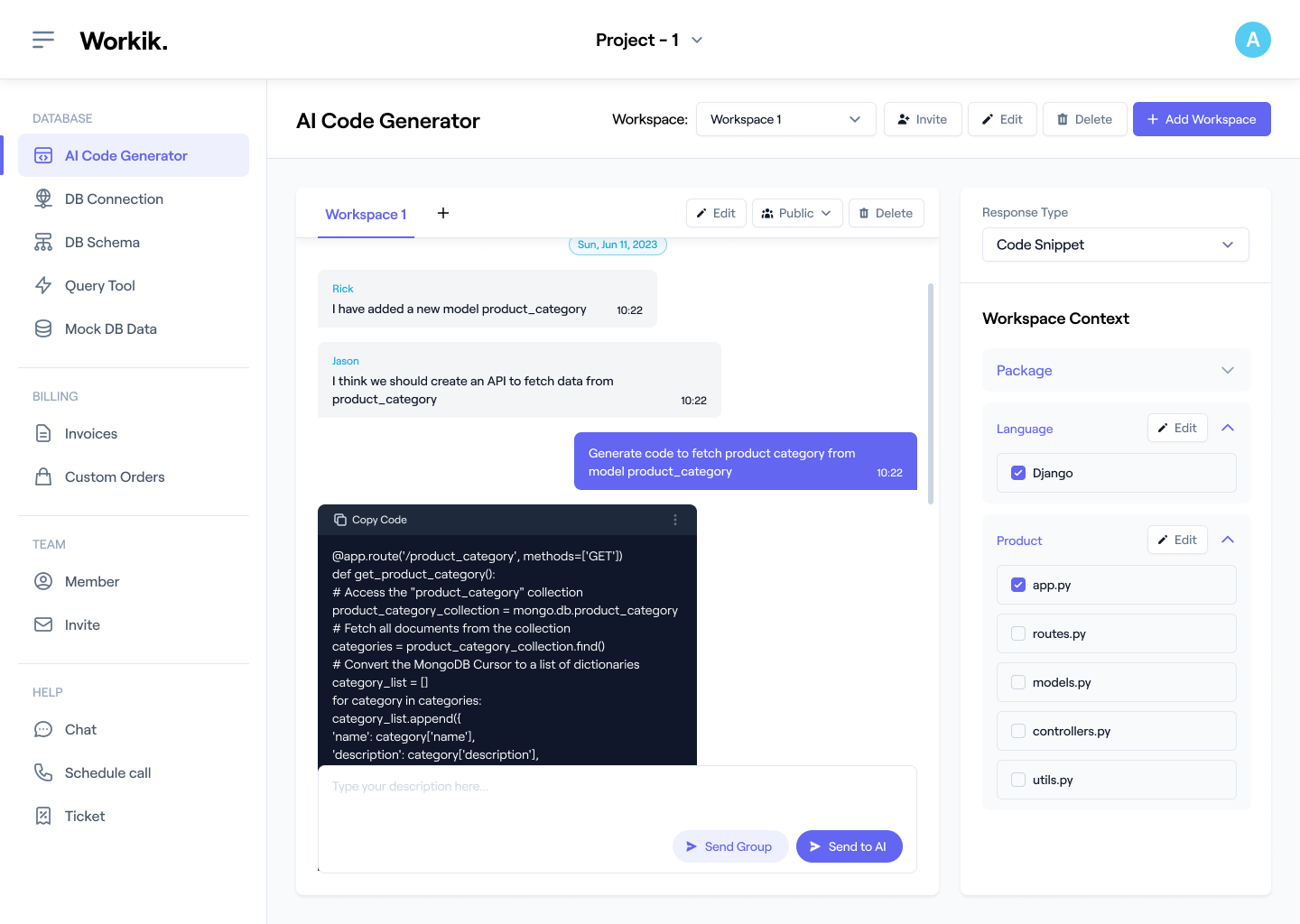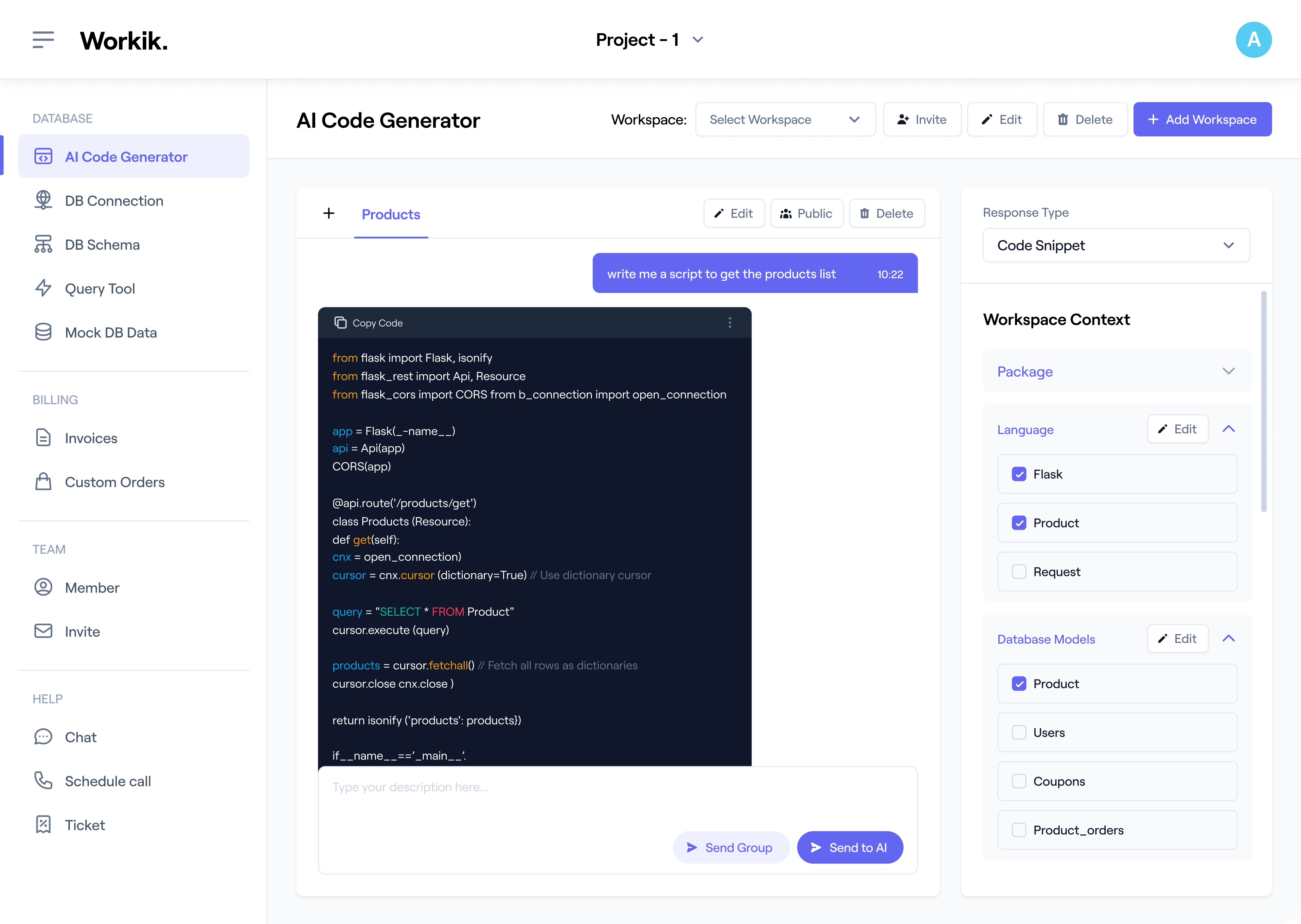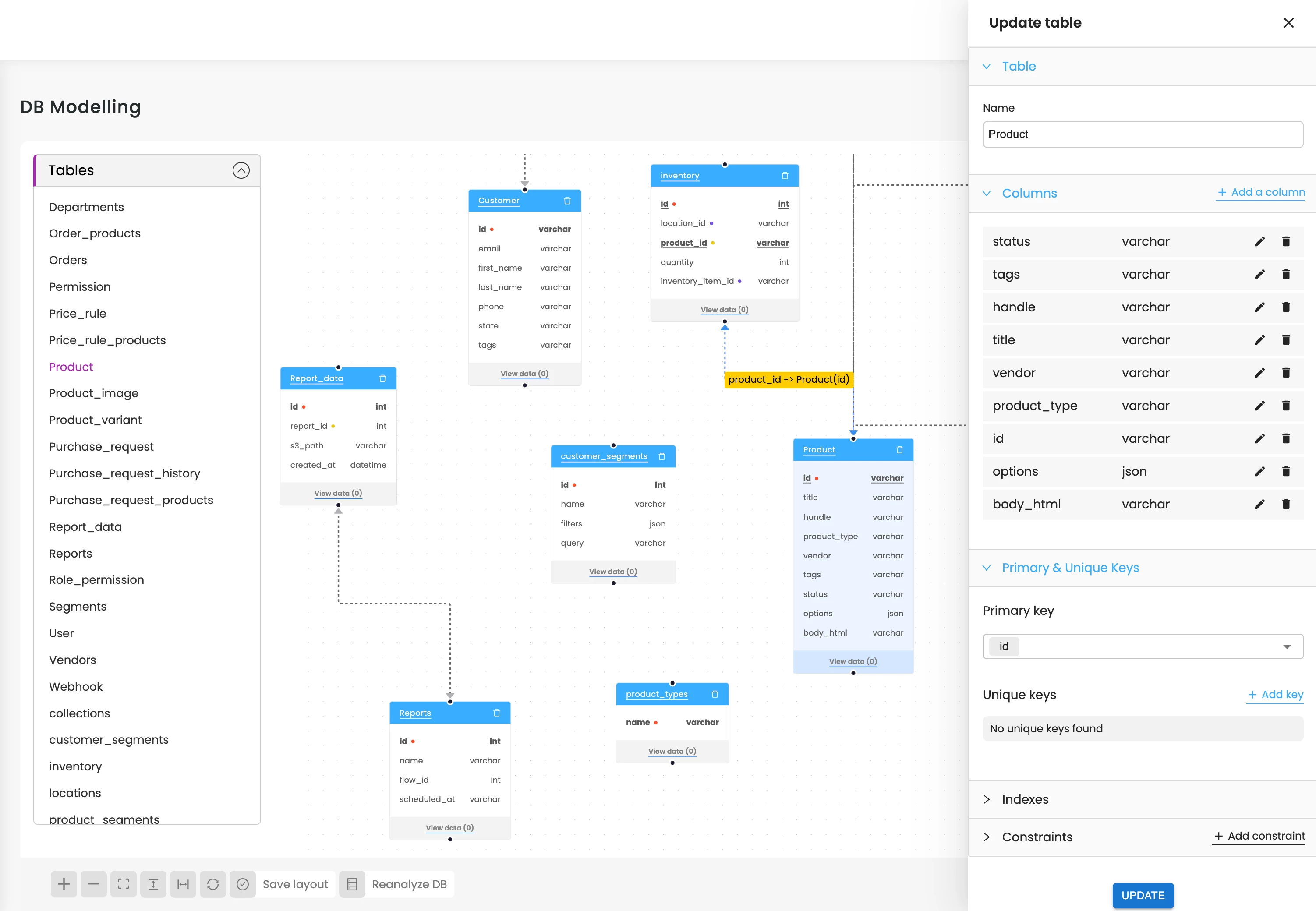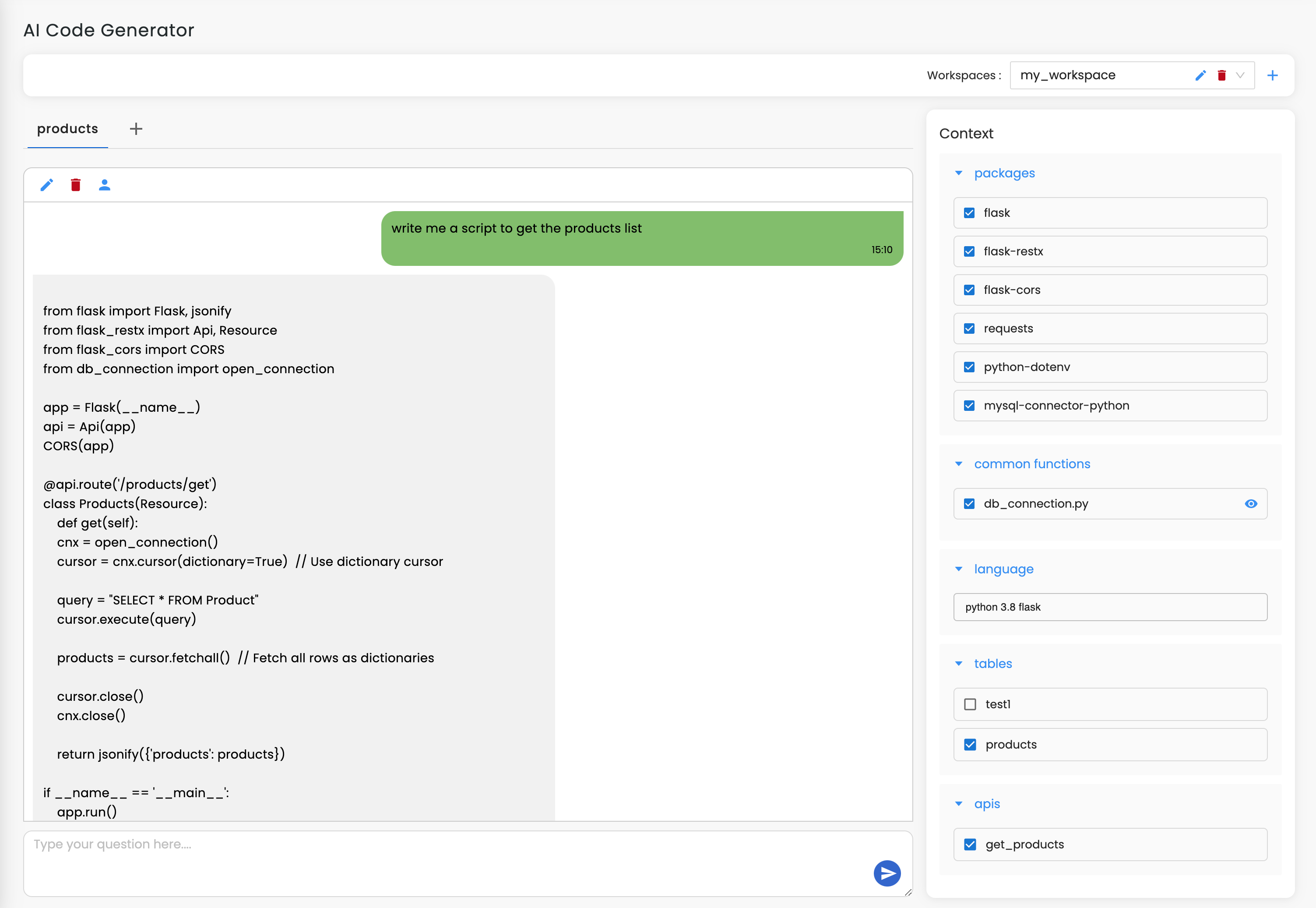
Join our community to see how developers are using Workik AI everyday.
Features

Secure API Policies
AI helps to set-up authentication, rate limiting, and traffic control with OAuth2, OpenID Connect, and JWT integrations.

Optimize Request Handling
Enable intelligent load balancing and circuit breaking with AI-tuned Envoy Proxy or NGINX for seamless traffic flow.

Generate API Documentation
Create OpenAPI/Swagger docs with endpoint mapping, request formats, and error handling configured by AI.

Monitor API Performance
Integrate Prometheus and Grafana for tracking of latency, throughput, and error rates with AI-curated metrics.
How it works
Create your Workik account in seconds and start configuring secure and efficient API gateways without hassle.
Connect your API project from GitHub, GitLab, or Bitbucket. Specify frameworks, protocols like REST or GraphQL, and include authentication methods for customized AI solutions.
Leverage AI for API security policies, route configurations, and performance optimizations. Generate detailed documentation, define throttling rules, and set up dynamic load balancing for seamless scalability.
Collaborate with your team in Workik to refine configurations, monitor traffic using integrated dashboards, and resolve issues faster with AI-driven insights.


Expand
.png)
.png)
Expand


Expand


Expand


Expand


Expand


Expand


TESTIMONIALS
Real Stories, Real Results with Workik
Workik AI simplified API security and JWT setup, saving me hours!

Mario Ramirez
Backend Engineer
Dynamic routing and load balancing using Workik AI made scaling effortless.

Sheetal Patel
DevOps Specialist
Workik AI’s instant OpenAPI docs streamlined onboarding and secured our APIs.

Mark Johnson
Technical Lead
What are the popular use cases of Workik AI Secure API Gateway Generator?


Popular API gateway use cases of Workik AI for developers include, but are not limited to:
* Create secure policies like OAuth2, JWT, and IP whitelisting.
* Configure intelligent routing with AI-powered traffic management for microservices.
* Generate OpenAPI/Swagger documentation for seamless team onboarding.
* Monitor performance with AI-integrated dashboards, tracking latency and error rates.
* Implement rate limiting and throttling rules to prevent abuse and ensure fair usage.
* Optimize scalability with AI-tuned load balancing for high-traffic applications.
What kind of contexts can I add in Workik AI-powered Secure API Gateway Generator?


Although adding context is optional, adding it enhances the output quality, allowing the AI to tailor gateway configuration to your specific API project. You can:
* Connect to GitHub, GitLab, or Bitbucket for seamless gateway deployment.
* Specify API protocols like REST, GraphQL, or WebSocket for optimized configurations.
* Include API authentication methods such as OAuth2, API Keys, or JWT for secure access.
* Upload existing OpenAPI/Swagger files to generate documentation and endpoint mappings.
* Provide traffic patterns or user load data for AI-driven scalability and routing adjustments.
Does Workik AI support zero-downtime API updates?


Yes, Workik AI enables smooth rollouts by configuring blue-green deployments or canary releases. For instance, you can test new versions of APIs with a small user group before scaling, ensuring stability while introducing changes.
How does Workik AI help secure APIs from evolving threats?


Workik AI continuously updates security configurations to defend against threats like DDoS attacks and injection vulnerabilities. For example, it can dynamically adjust rate-limiting thresholds during traffic spikes and suggest headers to prevent common exploits like cross-site scripting (XSS).
Can Workik AI gateway generator handle hybrid or on-premise deployments?


Yes, For example, it can generate gateway configurations that securely route traffic between cloud APIs and on-premise databases, using tools like reverse proxies and VPN tunnels for added security. This is ideal for industries like finance or healthcare, where data residency is critical.
Can Workik AI Secure API Gateway Generator assist with third-party API integrations?


Yes, Workik AI ensures that your application can safely connect with services like Stripe, Twilio, or Firebase. For example, it can auto-generate access controls and logging for external API endpoints, improving security while maintaining traceability.
How does Workik AI improve API versioning and lifecycle management?


Workik AI ensures compatibility for legacy clients while rolling out updates. AI suggests version-specific policies and optimizations, like throttling higher traffic on outdated versions to encourage migrations. For example, AI can help set up conditional routing based on client requests to direct users to the correct API version.
Generate Code For Free

API Gateway: Question and Answer
An API gateway is a server or service that acts as an entry point for client requests to interact with backend services. It handles API request routing, security, traffic control, and monitoring, serving as a single layer to manage multiple microservices. API gateways simplify communication between clients and services.
Popular frameworks and tools used with API gateways include:
Microservices Frameworks:
Spring Boot, Express.js, Flask
Gateway Tools:
Kong, AWS API Gateway, NGINX
Security:
OAuth2, OpenID Connect, JWT
Monitoring:
Prometheus, Grafana, DataDog
Load Balancing:
Envoy Proxy, HAProxy
Documentation:
Swagger/OpenAPI
Popular use cases of API gateways include but are not limited to:
E-commerce:
Secure payments, manage high-traffic sales, and sync inventory with checkout services.
Streaming:
Route requests, maintain API versions, and optimize peak-time performance.
Finance:
Enforce secure integrations with payment processors and analytics platforms.
Healthcare:
Secure EHR communication and enable HIPAA-compliant patient portals.
IoT:
Centralize device communication and enable low-latency edge processing.
Social Media:
Streamline APIs for content sharing, analytics, and advertising tools.
Microservices Management:
Simplify interactions with unified routing and load balancing.
Career opportunities and technical roles for professionals in API gateways include Backend Developer, DevOps Engineer, API Architect, Cloud Engineer, Integration Specialist, Security Engineer, and Microservices Consultant.
Workik AI provides comprehensive assistance for API gateway development, including:
Configuration Generation:
Automates setup for authentication, rate limiting, and routing rules.
Documentation:
Instantly generates OpenAPI/Swagger documentation for easier team collaboration.
Security:
Configures security protocols like OAuth2, API Keys, and JWT for robust access control.
Traffic Management:
Suggests optimal load balancing and throttling rules based on traffic patterns.
Debugging Support:
Analyzes API logs and flags errors for faster troubleshooting.
Scalability:
Configures dynamic routing and cloud-native gateway features for seamless scaling.
Performance Insights:
Monitors latency, throughput, and failure rates using integrated dashboards.
Cross-Environment Consistency:
Replicates gateway configurations across staging, testing, and production environments.
Explore more on Workik
Get in touch
Don't miss any updates of our product.
© Workik Inc. 2025 All rights reserved.

